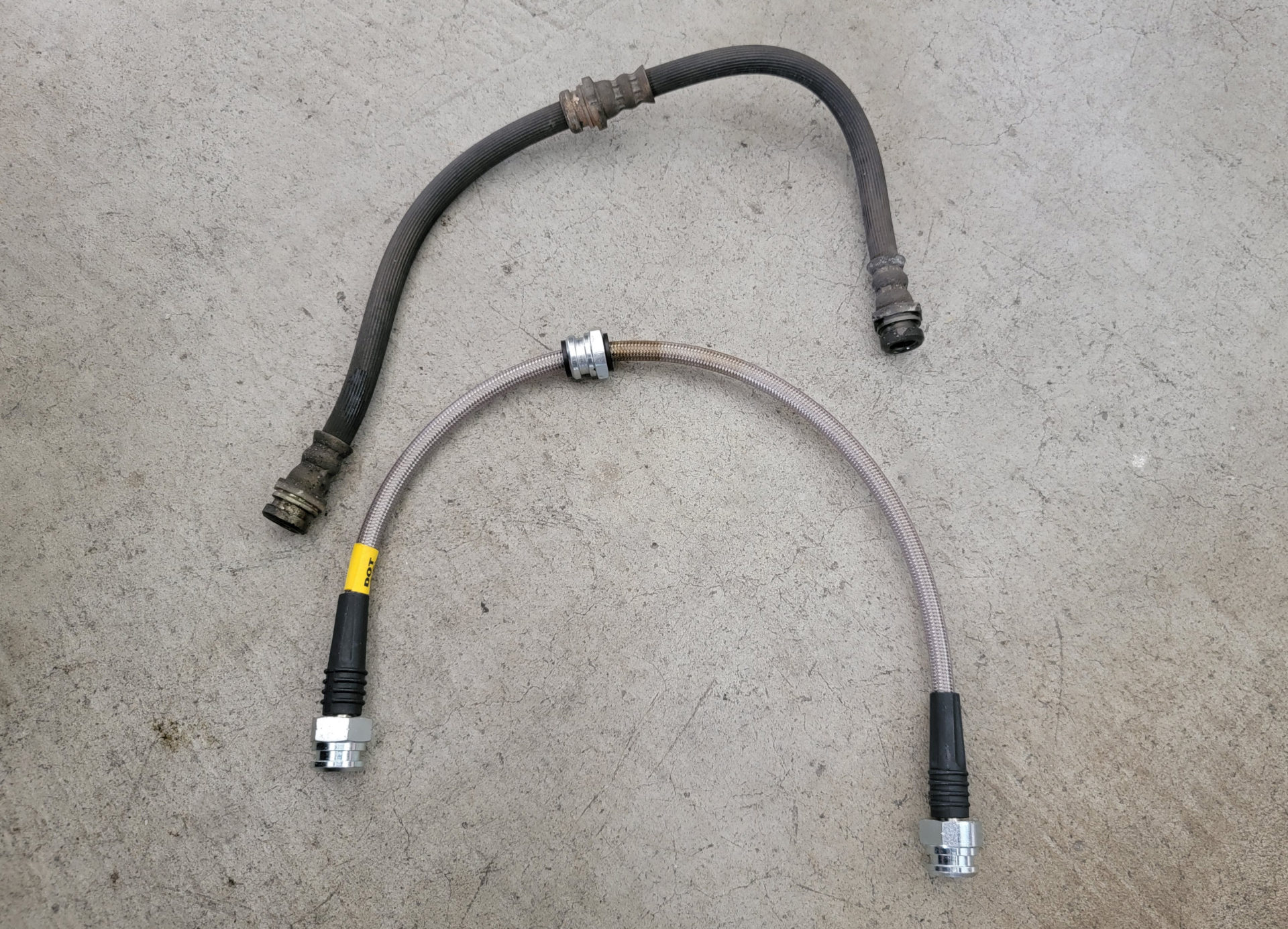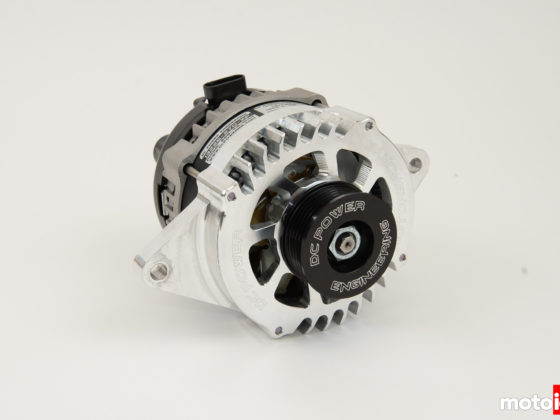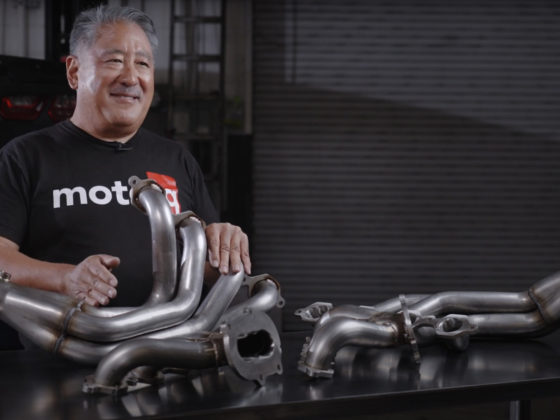 We started with the rear brakes and bled the calipers in a Right-Rear, Left-Rear, Right-Front, Left-Front pattern. We attached a clear line to the bleed nipple and started to bleed the brakes the old-fashioned way (and the way most professional race teams do today), by pumping the pedal a few times and holding pressure on the pedal, meanwhile another person opens the caliper bleed screw, which allows for the old fluid to come out. As the pedal hits the floor, the bleed screw is closed, and then the pattern of pumping the pedal a few times and then holding pressure is repeated until the line is flushed.
We started with the rear brakes and bled the calipers in a Right-Rear, Left-Rear, Right-Front, Left-Front pattern. We attached a clear line to the bleed nipple and started to bleed the brakes the old-fashioned way (and the way most professional race teams do today), by pumping the pedal a few times and holding pressure on the pedal, meanwhile another person opens the caliper bleed screw, which allows for the old fluid to come out. As the pedal hits the floor, the bleed screw is closed, and then the pattern of pumping the pedal a few times and then holding pressure is repeated until the line is flushed.
The dark, cloudy coloration of the brake fluid gives me a lot of confidence to suspect that the fluid has never been changed in 30 years. I have personally bought a lot of old cars over the years but this is right up there as one of the worse that I’ve seen. This picture does not look too bad because there’s a good portion of crystal-clear SRF diluting how bad the fluid actually was. This photo is of the second bottle of fluid that was flushed through the lines.
 Once the rear brakes lines were flushed and mostly clear SRF was coming out of the rear calipers, we started bleeding the fronts. This extremely dark coloration shows how bad the fluid was. Between the front and rear brakes, we went through over four water bottles of brake fluid to flush out all of the ancient junk that was left in the lines and calipers.
Once the rear brakes lines were flushed and mostly clear SRF was coming out of the rear calipers, we started bleeding the fronts. This extremely dark coloration shows how bad the fluid was. Between the front and rear brakes, we went through over four water bottles of brake fluid to flush out all of the ancient junk that was left in the lines and calipers.
 Once the calipers were completely flushed, with a couple final RR, LR, RF, LF circuits of bleeding (yes this was a bit excessive, but so was the severity of the old fluid), we bled the clutch.
Once the calipers were completely flushed, with a couple final RR, LR, RF, LF circuits of bleeding (yes this was a bit excessive, but so was the severity of the old fluid), we bled the clutch.
I had to stop and take a picture of how bad the fluid was. I filled the water bottle this much of awful fluid before getting any of the new SRF to come out of the clutch slave cylinder. I’m not sure how this much fluid can be between the clutch master and slave cylinders, but this is what the clutch fluid and brake fluid looked like when it first came out of the car. Once clean and clear SRF started pumping out of the slave cylinder, we were done.
On the street, it never fails to feel gratifying when driving a car for the first time with new stainless steel fluid and Castrol SRF fluid. The brake pedal feels rock solid and has much better consistency and feel to it. In the canyons, the fluid is now not a concern and the car brakes with a firm pedal each time. The pads will likely be the next weakest link but they probably won’t find their limitation on the street.
I highly recommend installing quality stainless steel brake lines (like from StopTech) and Castrol SRF fluid to any performance car. If you don’t remember the last time you bled your brakes, it’s probably time to do it now. I actually had to pay for these products myself, so these comments are not “bought”, but rather from a personal experience and the desire to drive home the importance to not overlook something as important as your brakes. So feel free to buy any quality and reputable stainless steel brake lines




13 comments
Thanks for the brake fluid recommendation. Will it work on any car? I will put it in my track 2008 miata for sure, but my daily 2011 Golf TDI needs new brake fluid, as well.
I put SRF in all of my cars.
I wouldn’t do any serious driving with a master cylinder of unknown age and condition that’s had fluid that bad in it for years.
What your thoughts on the Endless RF650 fluid? I’m running Endless RF650 and don’t have any issues with it, would there be any noticeable difference between the two in that case?
How do you feel about the using the 929 brake MC on the FD? Worth the effort if replacing the MC due to age even with stock calipers?
https://www.rx7club.com/suspension-wheels-tires-brakes-20/929-m-c-write-up-522474/
Most pro racing uses SRF and Endless. You’ll likely notice no difference between the two in most cases. However, I like SRF.
The 929 MC is good but I have not personally tried it. I may do it later.
I know Billy prefers SRF but I use endless and the majority of the teams I work with do as well. Supposedly endless is the least compressible fluid on the market but I have no data on this, just anecdotal stories from experienced brake engineers. Billy says that he has had fewer brake problems when driving for teams that use SRF. I would say you can’t go wrong with either and you can actually feel that they work better than mid-priced fluids like Motol and ATE.
Really important to install a master cylinder brace when doing modifications to the brake system. In fact, I would do this before any kind of upgrade. If you don’t believe me, have someone stomp on the brakes while you look at the master cylinder. It’s amazing how much the firewall flexes on a typical vehicle. All that movement happens BEFORE the piston in your master cylinder can actuate the slave cylinders, and finally your pads actually press against the discs. That massive amount of deflection happens every single time you step on the brake pedal, wasting not only energy but delaying brake actuation.
I agree, you can feel an MC brace more than steel braided lines!
I agree with the need for a brace, but you’re being a little over dramatic by saying all that (firewall) movement occurs before the slaves are actuated. Obviously you are at the bottom of the pedal when the firewall starts to flex. From there, you’re building extra pressure.
Funny timing, as I’m in the middle of rebuilding the brakes on a motorcycle that has been sitting for about eight years. It had fresh brake fluid nine years ago, but it’s been enough time for it to go completely bad, to the point where the brakes did not function. It’s likely that the floaty chunks of semi-solid that you found in the master cylinder reservoir had also formed from the deterioration of the brake fluid throughout the system. Flushing the system out will change the fluid, but much of the floaty chunkness won’t be moved from where it is and pass out of the bleed screw opening.
You’ll also find that deposits of broken down brake fluid attach to the surfaces in the system. They form differently on different materials throughout the system. Some wipe off easily, some look like rusty death but need only gentle scraping for the stuff to come off without damage, leaving an uncorroded base metal ready for final cleaning and reassembly. Some parts might actually be corroded, especially those parts made of iron or steel. It’s not uncommon for powersports vehicles that sit unused for a few years to have the brake fluid precipitate out solids that actually cause blockage of the brake lines. It can take some work to get them cleared out, or they may even have to be replaced.
When the system is that bad, the right way to get it back to 100 percent is to disassemble and clean everything. If proper tools and care are used during disassembly, there is no reason seals will be damaged and not be able to be reused, but they should be removed so that the brake fluid deterioration products in the seal grooves behind them can be cleaned out. Parts should be rinsed with an appropriate fluid. Note that “brake cleaner” is for removing oils from disc and drum surfaces. It is not at all suitable for cleaning pressure seals and dust boots. I use isopropyl alcohol. I’ll typically chase that by flushing with a large volume of water under a faucet. Follow that with another alcohol rinse and blast it dry with compressed air to get the water out 100%. Reassemble wetted seals (not dust boots, though) either with brake parts assembly lube or just plain brake fluid. It’s substantial labor, but if done carefully and you’re lucky regarding corrosion, it may not require any parts be purchased.
On a car, obviously do not put alcohol or water into the hard lines on the vehicle. You don’t have any assurance of getting it all out, which is a must. I haven’t had to do anything like this on a car, but would suggest flushing with enough cheap DOT3 or DOT4 to clear out any old gunk and save on the SRF bill. This might also be a place where hooking up to a system that will cycle the ABS system will pay dividends, as the fluid throughout the many intricate passages and valves of the ABS/ESC module has also been deteriorating and should be cycled out.
When you’re done, all you’ll be chasing out of the system is air. You’ll know that 100 percent of the brake fluid in the system is new and fresh, rather than supposing that you probably went far enough in an exponential dilution problem. You won’t have old fluid and deterioration byproducts lurking in the nooks and crannies between pistons and bores and around seals where the heat will reach first.
Obviously, it’s a lot easier to just keep fluid changed at appropriate intervals, even (perhaps especially) on vehicles that don’t see much use.
My thinking on brake fluid is a bit different. I’ve generally seen other areas of the brake system fail to perform due to overtemperature long before fresh fluid in the RBF600 class or even ATE Typ200 will be a problem. Boiling fluid has in my experience been associated with either old fluid that had absorbed moisture, dramatically insufficient cooling causing the system to operate at too high a temperature for all its components, or bleeding improperly with a “pressure bleeder” that failed to use a diaphragm between the pressurized air and fluid. There are applications in motorsports that require the highest boiling point fluids, but my experience leads me to believe that most of us are better off flushing more often with much less expensive fluids that have only somewhat lower boiling points. I’ve generally considered the wet boiling point irrelevant for performance applications. I write this knowing that Billy’s experience is different (but not without overlap when it comes to brakes) than my own. I’m not saying he’s wrong, just that other approaches also work well.
One more thing, I noticed that in the third photo on the first page, there doesn’t appear to be a pad service underway, but the retaining wire for the pad retaining pins is not engaged with the upper pin. Seems to be a pad installation error there.
Hope this helps someone.
What do you think of first using a pressure bleeder to blast cheap brake fluid through the system to get all the crap out? We use a power sucker that uses compressed air to make a vacuum to draw a lot of fluid and to make sure all the old stuff is gone.
Vacuum bleeder is fine, as it can’t be causing air to dissolve into the fluid. My point above was that if there are solid or semi-solid precipitates from decomposed brake fluid in the system, any amount of flushing the assembled system is likely to leave some or most of them behind. If you went back and really flushed out all the cheap brake fluid using the traditional bleeding method, it would be OK to use a garden sprayer type bleeder that pressurizes air on the brake fluid without a separating diaphragm for the cheap-fluid flush. But I wouldn’t own one just for that and then have it taking up space the rest of the time for no purpose. The dissolved air is enough of an issue that I’ve heard of high level race teams putting newly opened containers of brake fluid under vacuum overnight before they are to be used.
Hey Mike, a vacuum bleeder is preferable to a pressure bleeder (if not bleeding fully manually). Some may argue this point as vacuum takes longer, but I’m not physically forcing air into expensive, premium brake fluid. One of the main reasons the top few brake fluids are expensive is that they contain less dissolved air, which is why they are less compressible to start with.